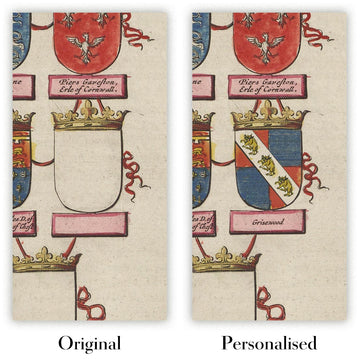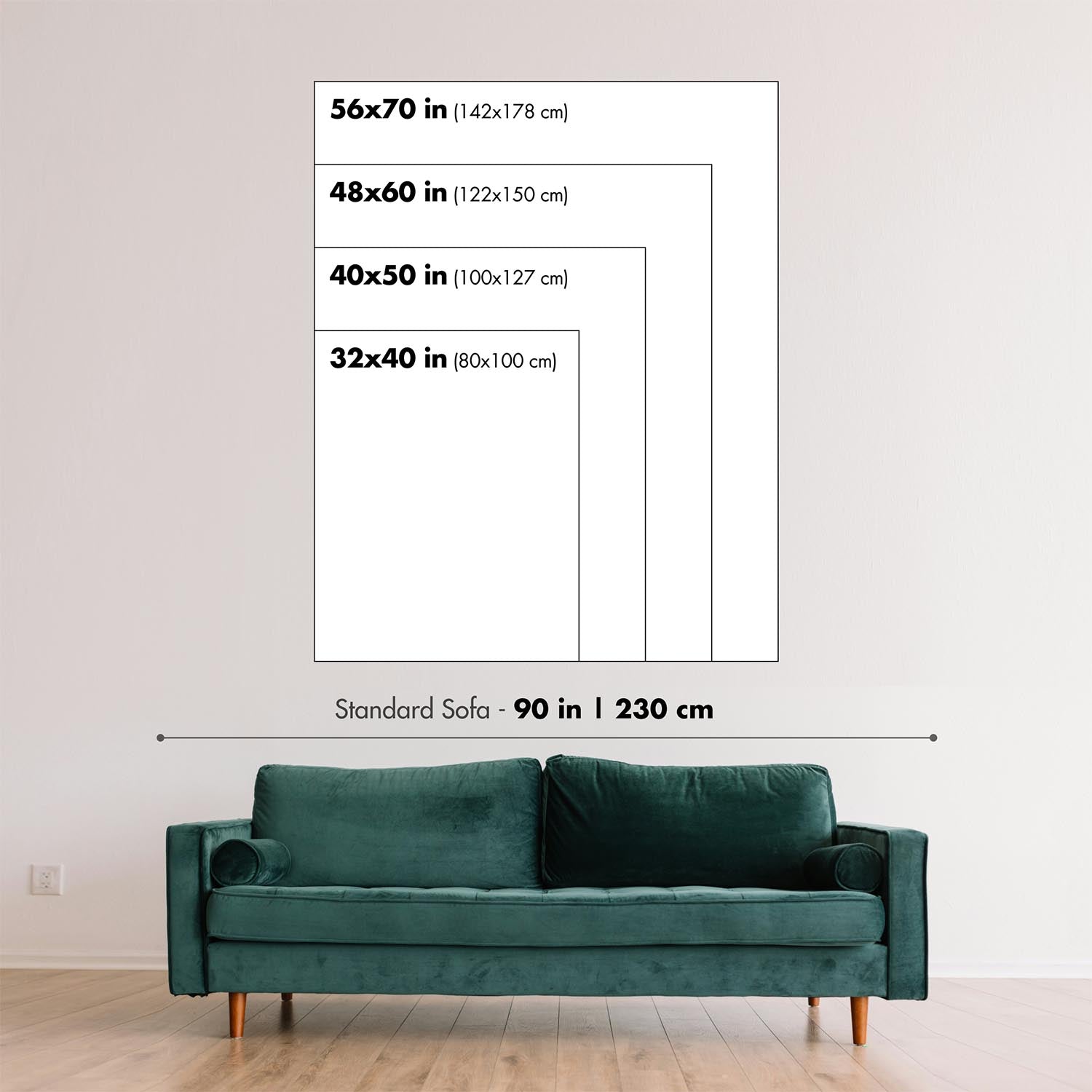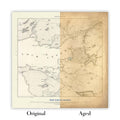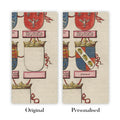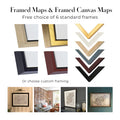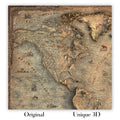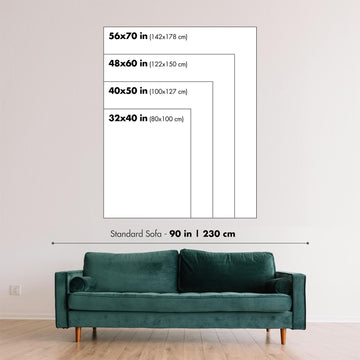- Handmade locally. No import duty or tax
- FREE worldwide delivery
- Love it or your money back (90 days)
- Questions? WhatsApp me any time
Own a piece of history
5,000+ 5 star reviews


Entra nella ricca storia della Rivoluzione Americana con questa squisita mappa del 1776, "Il Teatro d'Azione tra le Forze Britanniche e Americane." Creata dai rinomati cartografi Sayer & Bennett, questo capolavoro cartografico dettagliato cattura una delle battaglie iniziali fondamentali della guerra—la Battaglia di Long Island. La mappa illustra vividamente le manovre strategiche e gli scontri militari tra le forze britanniche e americane, offrendo uno sguardo affascinante sulle complessità tattiche dell'epoca.
La mappa non è solo una rappresentazione geografica ma un'infografica dinamica che trasmette il dramma in evoluzione della battaglia. Traccia meticolosamente lo sbarco britannico a Gravesend Bay, le linee difensive americane lungo Gowanus Heights e la cruciale manovra di fiancheggiamento attraverso Jamaica Pass. La narrazione visiva è arricchita da annotazioni e simboli che evidenziano le posizioni militari chiave, i movimenti delle truppe e il successivo ritiro americano a Brooklyn. Questo livello di dettaglio offre un'illuminante visione del pensiero strategico e delle sfide affrontate da entrambe le parti.
Aggiungendo alla sua importanza storica, la mappa si basa sui rilievi del Maggiore Samuel Holland, una figura prominente nella cartografia del XVIII secolo. L'esperienza di Holland ha garantito l'accuratezza e il dettaglio della mappa, rendendola una risorsa inestimabile per comprendere gli elementi geografici e tattici della battaglia. La pubblicazione di questa mappa da parte di Sayer & Bennett poco dopo la battaglia sottolinea la sua importanza come documento contemporaneo di un momento critico nella Guerra Rivoluzionaria.
La mappa funge anche da ricco deposito di informazioni geografiche, estendendosi da Courtland sul fiume Hudson a Sandy Hook e Middletown nel New Jersey. Presenta città, insediamenti, strade e dettagli topografici, fornendo una visione completa della regione durante la fine del XVIII secolo. L'inclusione della flotta britannica nella Baia di New York e delle fortificazioni americane a Long Island e Manhattan arricchisce ulteriormente la narrazione della mappa, offrendo una visione olistica degli aspetti militari e navali del conflitto.
Questa mappa è una testimonianza dell'arte e della precisione della cartografia del XVIII secolo, fondendo narrazione storica con dettagli geografici. Rappresenta un artefatto prezioso per storici, collezionisti e chiunque abbia una passione per la Rivoluzione Americana. Il design intricato della mappa e il contesto storico la rendono un'aggiunta affascinante a qualsiasi collezione, offrendo una finestra sul paesaggio strategico e geografico di uno dei conflitti più definitivi dell'America.
Luoghi su questa mappa
- Città di New York
- Long Island
- Staten Island
- New Jersey
- Connecticut
- Fiume Hudson
- East River
- The Sound
- Oceano Atlantico
- Gravesend Bay
- Gowanus Heights
- Brooklyn
- Manhattan
- Sandy Hook
- Middletown
- Courtland
- Amboy
- Filadelfia
- Newark Bay
- Hackinsack
- New Rochelle
- Stamford
- Hempstead Plains
- Jamaica Pass
- Greenwich
- White Plains
- Baia di Tappan
- Haverstraw
- Poughkeepsie
- Esopus
Caratteristiche e Monumenti Notabili
- Sito di sbarco britannico: Baia di Gravesend nell'est di Long Island.
- Linee difensive americane: Si estendono dalla costa verso est lungo Gowanus Heights.
- Movimenti delle truppe britanniche: Due colonne che attaccano le forze americane e l'attacco principale attraverso Jamaica Pass.
- Ritiro americano: Verso le fortificazioni nel villaggio di Brooklyn sul fiume East.
- Flotta britannica assemblata: Nella baia di New York.
- Caratteristiche geografiche: Città principali, insediamenti, strade e residenze.
- Mappa in evidenza: Mostra la strada da Amboy a Philadelphia.
- Dettagli topografici: Inclusi fiumi, baie e colline.
- Posizioni militari: Sia le posizioni britanniche che americane sono contrassegnate.
- Luoghi chiave: Come Manhattan, Long Island, Staten Island e parti del New Jersey.
- Corpi idrici: Fiume Hudson, East River, The Sound e Oceano Atlantico.
- Contesto storico: La mappa è stata pubblicata poco dopo la battaglia, riflettendo le conseguenze immediate e i movimenti strategici.
- Dettagli cartografici: Basati sui sondaggi del Maggiore Holland, fornendo accuratezza e dettaglio.
- Legenda della mappa: Spiegando simboli e contrassegni utilizzati sulla mappa.
- Rosone della bussola: Indica le direzioni sulla mappa.
- Barra di scala: Per misurare le distanze sulla mappa.
- Annotazioni: Descrivono eventi e movimenti chiave durante la battaglia.
- Narrativa storica: La mappa racconta la storia della Battaglia di Long Island attraverso la rappresentazione visiva.
- Strategia britannica: Illustra attraverso la rappresentazione dei movimenti delle truppe e degli sbarchi.
- Fortificazioni americane: Mostrate a Brooklyn e in altri punti strategici.
- Presenza navale: Rappresenta il posizionamento strategico della flotta britannica.
- Confini geopolitici: Indica i confini di New York, New Jersey e Connecticut.
- Monumenti storici: Siti importanti legati alla battaglia e alla Guerra di Indipendenza.
- Stile visivo: Riflette le convenzioni artistiche e cartografiche della fine del XVIII secolo.
Contesto storico e di design
- Nome della mappa: Il Luogo dell'Azione tra le Forze Britanniche e Americane. O un Piano Autentico della Parte Occidentale di Long Island, con l'ingaggio del 27 agosto 1776 tra le Forze del Re e gli Americani . . . dai Sondaggi del Maggiore Holland.
- Data di creazione: 1776
- Cartografo o editore: Sayer & Bennett
- Contesto interessante sul cartografo: Sayer & Bennett erano editori di mappe prominenti nel XVIII secolo, noti per la produzione di mappe dettagliate e accurate. Pubblicarono questa mappa poco dopo la Battaglia di Long Island, e probabilmente competette con la mappa dello stesso evento di William Faden.
- Significato storico:
- Battaglia di Long Island: La mappa rappresenta la Battaglia di Long Island, una delle prime e significative battaglie della Rivoluzione Americana.
- Strategia britannica: La mappa illustra la strategia britannica per isolare il New England e ottenere il controllo del basso Hudson, mirando a isolare e sopraffare le colonie settentrionali.
- Ritirata americana: Documenta la ritirata delle forze americane verso Brooklyn e la loro successiva evacuazione a Manhattan, un momento critico nella battaglia.
- Argomenti e temi mostrati sulla mappa:
- Posizioni e movimenti militari: La mappa mostra lo sbarco britannico, i movimenti delle truppe e le posizioni difensive americane.
- Caratteristiche geografiche: Include città, insediamenti, principali caratteristiche topografiche, strade e abitazioni.
- Presenza navale: La flotta britannica assemblata nella baia di New York è rappresentata.
- Paesi e regioni mostrati sulla mappa:
- Stati Uniti: La mappa si concentra sull'area intorno a New York City, comprese parti del New Jersey, Long Island e Connecticut.
- Design o stile della mappa:
- Mappa tematica infografica: Trasmette informazioni dettagliate sulla battaglia e sui movimenti delle truppe in modo illustrativo.
- Cartografia storica: La mappa è stata basata su rilievi del Maggiore Holland e riflette lo stile cartografico della fine del XVIII secolo.
- Contesto aggiuntivo:
- Evacuazione britannica di Boston: La mappa segue la ritirata britannica da Boston e la loro successiva strategia per controllare New York.
- Importanza strategica di New York: La mappa evidenzia l'importanza di New York nel piano britannico per dominare le colonie settentrionali.
Si prega di controllare attentamente le immagini per assicurarsi che una specifica città o luogo sia mostrato su questa mappa. Puoi anche contattarci e chiedere di controllare la mappa per te.
Questa mappa appare ottima in ogni dimensione, ma consiglio sempre di optare per una dimensione più grande se hai spazio. In questo modo puoi facilmente distinguere tutti i dettagli.
Questa mappa appare fantastica in dimensioni fino a 70 pollici (180 cm). Se stai cercando una mappa più grande, per favore contattaci.
Si prega di notare: le etichette su questa mappa sono difficili da leggere se ordini una mappa che è 20 pollici (50 cm) o più piccola. La mappa è comunque molto attraente, ma se desideri leggere facilmente la mappa, ti preghiamo di acquistare una dimensione più grande.
Il modello nelle immagini dell'inserzione tiene la versione 16x20 pollici (40x50 cm) di questa mappa.
La quinta immagine dell'inserzione mostra un esempio del mio servizio di personalizzazione della mappa.
Se stai cercando qualcosa di leggermente diverso, dai un'occhiata alla mia collezione delle migliori vecchie mappe per vedere se qualcosa attira la tua attenzione.
Per favore contattami per controllare se un certo luogo, punto di riferimento o caratteristica è mostrato su questa mappa.
Questo sarebbe un regalo meraviglioso per un compleanno, Natale, Festa del Papà, partenza dal lavoro, anniversario o inaugurazione della casa per qualcuno delle aree coperte da questa mappa.
Questa mappa è disponibile come stampa giclée su carta opaca archiviabile senza acidi, oppure puoi acquistarla incorniciata. La cornice è una bella e semplice cornice nera che si adatta alla maggior parte degli stili. Ti preghiamo di contattarci se desideri un colore o un materiale diverso per la cornice. Le mie cornici sono dotate di un vetro acrilico super chiaro di qualità museale (perspex/acrylite), che è significativamente meno riflettente del vetro, più sicuro e arriverà sempre in perfette condizioni.
This map is also available as a float framed canvas, sometimes known as a shadow gap framed canvas or canvas floater. The map is printed on artist's cotton canvas and then stretched over a handmade box frame. We then "float" the canvas inside a wooden frame, which is available in a range of colours (black, dark brown, oak, antique gold and white). This is a wonderful way to present a map without glazing in front. See some examples of float framed canvas maps and explore the differences between my different finishes.
For something truly unique, this map is also available in "Unique 3D", our trademarked process that dramatically transforms the map so that it has a wonderful sense of depth. We combine the original map with detailed topography and elevation data, so that mountains and the terrain really "pop". For more info and examples of 3D maps, check my Unique 3D page.
For most orders, delivery time is about 3 working days. Personalised and customised products take longer, as I have to do the personalisation and send it to you for approval, which usually takes 1 or 2 days.
Please note that very large framed orders usually take longer to make and deliver.
If you need your order to arrive by a certain date, please contact me before you order so that we can find the best way of making sure you get your order in time.
I print and frame maps and artwork in 23 countries around the world. This means your order will be made locally, which cuts down on delivery time and ensures that it won't be damaged during delivery. You'll never pay customs or import duty, and we'll put less CO2 into the air.
All of my maps and art prints are well packaged and sent in a rugged tube if unframed, or surrounded by foam if framed.
I try to send out all orders within 1 or 2 days of receiving your order, though some products (like face masks, mugs and tote bags) can take longer to make.
If you select Express Delivery at checkout your order we will prioritise your order and send it out by 1-day courier (Fedex, DHL, UPS, Parcelforce).
Next Day delivery is also available in some countries (US, UK, Singapore, UAE) but please try to order early in the day so that we can get it sent out on time.
My standard frame is a gallery style black ash hardwood frame. It is simple and quite modern looking. My standard frame is around 20mm (0.8in) wide.
I use super-clear acrylic (perspex/acrylite) for the frame glass. It's lighter and safer than glass - and it looks better, as the reflectivity is lower.
Six standard frame colours are available for free (black, dark brown, dark grey, oak, white and antique gold). Custom framing and mounting/matting is available if you're looking for something else.
Most maps, art and illustrations are also available as a framed canvas. We use matte (not shiny) cotton canvas, stretch it over a sustainably sourced box wood frame, and then 'float' the piece within a wood frame. The end result is quite beautiful, and there's no glazing to get in the way.
All frames are provided "ready to hang", with either a string or brackets on the back. Very large frames will have heavy duty hanging plates and/or a mounting baton. If you have any questions, please get in touch.
See some examples of my framed maps and framed canvas maps.
Alternatively, I can also supply old maps and artwork on canvas, foam board, cotton rag and other materials.
If you want to frame your map or artwork yourself, please read my size guide first.
Alcune delle mie vecchie mappe sono ora disponibili come tele incorniciate. Per favore contattami se desideri ordinare una dimensione che non è disponibile nel mio negozio.
Le vecchie mappe su tela sono un'alternativa interessante alle mappe incorniciate in modo convenzionale. A seconda del tuo gusto personale e dell'arredamento della stanza, le mappe su tela possono "risaltare" un po' di più rispetto a una mappa incorniciata.
My maps are extremely high quality reproductions of original maps.
I source original, rare maps from libraries, auction houses and private collections around the world, restore them at my London workshop, and then use specialist giclée inks and printers to create beautiful maps that look even better than the original.
My maps are printed on acid-free archival matte (not glossy) paper that feels very high quality and almost like card. In technical terms the paper weight/thickness is 10mil/200gsm. It's perfect for framing.
I print with Epson ultrachrome giclée UV fade resistant pigment inks - some of the best inks you can find.
I can also make maps on canvas, cotton rag and other exotic materials.
Learn more about The Unique Maps Co.
Map personalisation
If you're looking for the perfect anniversary or housewarming gift, I can personalise your map to make it truly unique. For example, I can add a short message, or highlight an important location, or add your family's coat of arms.
The options are almost infinite. Please see my map personalisation page for some wonderful examples of what's possible.
To order a personalised map, select "personalise your map" before adding it to your basket.
Get in touch if you're looking for more complex customisations and personalisations.
Map ageing
I have been asked hundreds of times over the years by customers if they could buy a map that looks even older.
Well, now you can, by selecting Aged before you add a map to your basket.
All the product photos you see on this page show the map in its Original form. This is what the map looks like today.
If you select Aged, I will age your map by hand, using a special and unique process developed through years of studying old maps, talking to researchers to understand the chemistry of aging paper, and of course... lots of practice!
If you're unsure, stick to the Original colour of the map. If you want something a bit darker and older looking, go for Aged.
Se non sei soddisfatto del tuo ordine per qualsiasi motivo, contattami per un rimborso senza problemi. Si prega di consultare la nostra politica di reso e rimborso per ulteriori informazioni.
Sono molto sicuro che ti piacerà la tua mappa restaurata o la stampa d'arte. Lo faccio dal 1984. Sono un venditore Etsy a 5 stelle. Ho venduto decine di migliaia di mappe e stampe d'arte e ho oltre 5.000 recensioni reali a 5 stelle.
Utilizzo un processo unico per restaurare mappe e opere d'arte che richiede molto tempo e lavoro. Trovare le mappe e le illustrazioni originali può richiedere mesi. Utilizzo tecnologia all'avanguardia e incredibilmente costosa per scannerizzare e restaurarle. Di conseguenza, garantisco che le mie mappe e stampe d'arte siano superiori alle altre - ecco perché posso offrire un rimborso senza problemi.
Quasi tutte le mie mappe e stampe d'arte sembrano fantastiche a grandi dimensioni (200 cm, 6,5 piedi+) e posso anche incorniciarle e consegnarle a te, tramite un corriere speciale per oggetti di grandi dimensioni. Contattami per discutere delle tue esigenze specifiche.
Or try searching for something!























